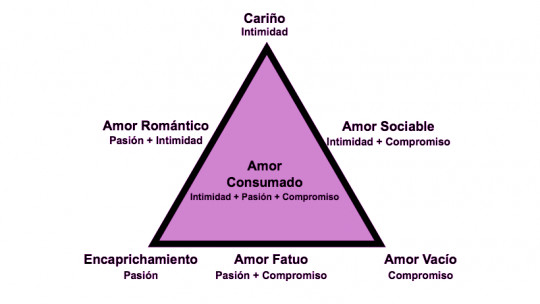
It is clear that love is a complicated concept. What is love? What does love feel like? What types of love are there?
Many theories have tried to explain love, from Plato to Erich Fromm. However, in this article we will focus on talking about one of the most prominent and studied theories: it is Sternberg’s triangular theory of love
Robert Sternberg developed this theory throughout the 80s and 90s and in it he proposes that there are three essential components of love: intimacy, passion and commitment.
The three components of love according to Sternberg
Sternberg’s triangular theory of love proposes that these three components are interrelated. According to the author, intimacy, passion and commitment combine to produce all the types of love that we observe in relationships between people. In this way, romantic love is the combination of passion and intimacy, but without commitment being present. On the other hand, empty love would consist only of the presence of commitment, without intimacy and passion.
Intimacy and commitment are two components that tend to be quite constant in relationships. That is to say, Once they are established in a relationship, they can last over time However, passion is considered less stable and much less predictable.

Another difference between the three components is how aware we are of them. For example, passion is usually quite evident. Either we feel sexual attraction to the other person or we don’t. Intimacy and commitment, for their part, are not always perceived so clearly. We may not realize how strong a commitment we have to our partner until it is tested by some external event, such as an illness of one of the members of the couple.
Below, we will look at each of these components in greater depth.
1. Privacy
Sternberg uses this word to refer to the emotional component of love For the author, intimacy means warmth, closeness, trust, connection and togetherness. It is important not to confuse this component with having intimacy or sexual relations with the other person.
2. Passion
Passion, as its name suggests, tells us about how passionate the relationship is. Passion is the emotion we feel when thinking about the other person, the butterflies in the stomach, thinking about that other person all the time, etc. Of course, also includes sexual attraction
Furthermore, Sternberg describes passion as a motivational component of love, since it motivates us to act, to pursue the object of our love, to write a message, propose a plan, prepare a dinner, etc.
3. Commitment
The third element of the triangular theory of love is commitment. Sternberg describes it as that moment when the person thinks: that’s it, I don’t need to look any further, this is the person. In addition, commitment is the only one of the three components that is conscious or intentional There is a long-term commitment. An example of the commitment component can be found in a couple that has been married for 60 years.
A relationship of this duration cannot be based solely on sexual attraction or intimacy. In 60 years of marriage we argue, we have disagreements, fights, etc. However, the relationship continues thanks to commitment.
The eight combinations of love according to Sternberg
As we said before, the three components can and do interact in different ways, which leads to different types of love. Sternberg’s triangular theory of love determines eight types of love: non-love, affection, infatuation, empty love, romantic love, sociable love, fatuous love, and consummate love. In the following list we see the combinations that give rise to each of the types of love:
As we can see in the previous list, a relationship without intimacy and passion that only has commitment is called empty love. If only intimacy is present, affection appears and we usually have a friendship with that person. As long as it lacks commitment, we cannot even say that it is a true friendship. And so we would continue with the rest of the components and their interactions.
Over the years, there has been much discussion about this Sternberg theory, indicating that perhaps things are not always as clear-cut as the triangle suggests and that It is not always so easy to locate ourselves in a type of love








